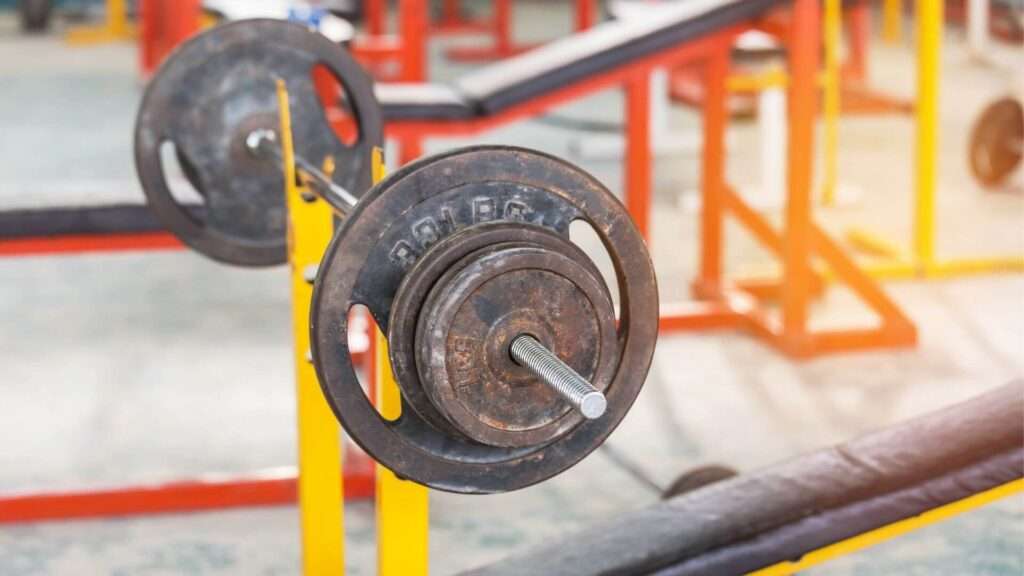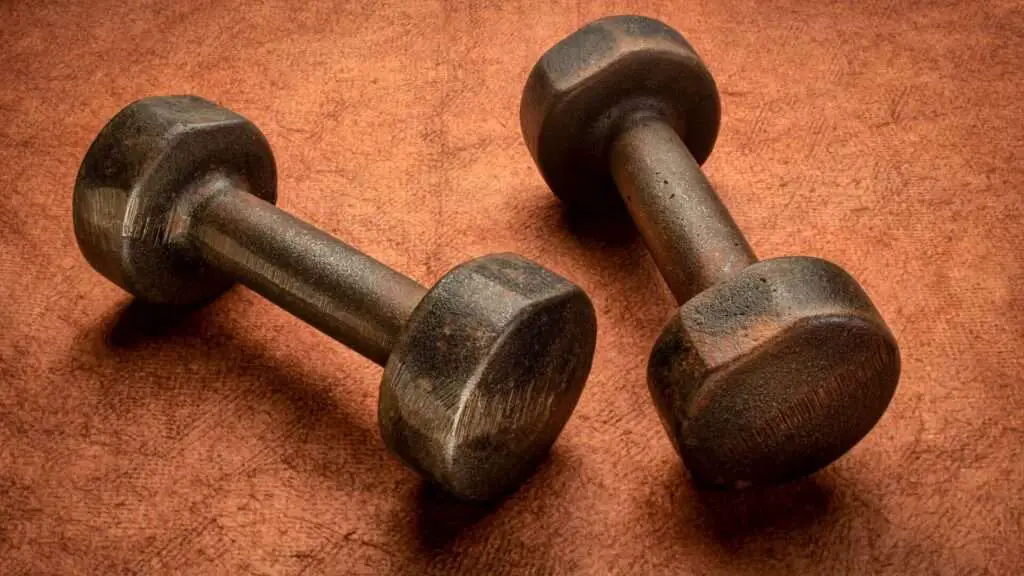Rusty gym weights are a common sight in many commercial gyms, particularly older ones. It is natural to assume that these old, rusty weights may be dangerous to use due to the potential for them to splinter or crumble.
However, with proper precautions, it is safe to use rusty gym weights for exercise at home or in the gym. It is important to handle these weights with care to prevent cuts and scrapes on the hands from the rust.
While rust itself is not directly harmful to the body, it is important to be aware of the potential risks associated with using rusty weights. If you want to learn more about using old, rusty gym weights, it is recommended to read more on the subject.
What are rusty gym weights
What is rust?
Corrosion known as rust takes place when iron and other metals are exposed to water and oxygen. Rust is actually a common name for a compound called iron oxide. The process of rusting occurs when iron atoms in the metal lose electrons and form iron oxide. This process is called oxidation.
Rust can occur on metal surfaces that are exposed to moisture and oxygen, such as iron and steel. Rust can also form on other metals, such as aluminum and copper, although the process is different and the corrosion is called differently.
Rust can form on metal surfaces that are exposed to water, such as in a humid or damp environment, or on metal surfaces that are exposed to saltwater.
Rust is often orange or red in color, but can also be brown or yellow. It can appear as flaky or powdery on the surface of the metal. Rust can weaken the structural integrity of the metal and make it less durable. It can also cause metal to become brittle and more prone to breaking.
Why Are Gym Weights Rusty?
Rusty gym weights can be a common problem for weightlifters, as rust can weaken the structural integrity of the weights and make them less safe to use. Rust can also affect the appearance of the weights and make them look unsightly.
Rust can form on weights that are not stored in a dry place, or if they are used in a humid or damp environment. For example, weights that are left outside or in a garage can be exposed to moisture and may rust more quickly than weights that are stored indoors.
Rust can also form over time if weights are not cleaned or maintained regularly. Sweat, oils, and dirt can accumulate on the surface of the weights and create an environment that is conducive to rust. Additionally, if weights are not properly oiled or coated to protect them from rust, they may rust more quickly.
How to Recognize Rusty Gym Weights:
Recognizing rusty gym weights is relatively easy as they typically have a distinct orange or red discoloration on their surface.
The rust may appear as flaky or powdery, and can be found on any metal surface of the weight, such as the handles or plates. Additionally, rust can cause a metallic smell and may be accompanied by a rough texture on the surface of the weight.
Another way to identify rust on weights is by looking for signs of corrosion. Corrosion can appear as pits or holes on the surface of the weight, and can be indicative of rust that has been present for an extended period of time.
Additionally, weights with rust may appear to be less shiny than their non-rusted counterparts, and may have a dull or matte finish.
If you’re not sure whether or not a weight is rusty, you can also check for rust by wiping the weight down with a clean cloth. If the cloth comes away with orange or red stains, this is a sign that the weight is rusty.
Exercising with rusted weights: Is it safe?

- Rust on gym weights is not inherently harmful for exercise, as long as the rust has not affected the weight’s structural integrity. This means that the weight is still safe to handle and lift, and the rust is only a cosmetic issue.
- Direct contact with rust may cause temporary skin discoloration, but it is not medically harmful. Rust is only dangerous to your health if it gets into your skin and let Clostridium bacteria in. There is no medical evidence that direct contact with rust results in anything other than skin discoloration.
Risk of infection
- If the rust has not punctured the skin, it poses no risk of infection. However, if a person has sustained any deep open wounds to their hands, they should abstain from working out with rusty weights to mitigate any potential risk of infection. In this case, it would be best to spend time resting and allowing the body to heal, rather than exercising.
- Even if the hands are bandaged, it’s still not worth the risk to work out with rusty weights.
Rust particles
- It is important to be aware that small rust particles may flake off from the weights from time to time. So, if a person has cuts that aren’t covered, they should put a bandage on them before working out to keep these rust particles from getting into the cuts.
- In addition, it would be prudent to avoid accidently inhaling these rust particles when they flake off. Inhaling rust particles could put the health at unnecessary risk.(Source)
In summary, It is safe to use rusty weights for exercise as long as the rust has not affected the weight’s structural integrity and it is not causing any skin punctures. However, if there are any open wounds, it is recommended to avoid using rusty weights to prevent the risk of infection. Additionally, it is important to be aware of rust particles flaking off and to take precautions such as bandaging cuts and avoiding inhaling the particles to protect your health.
Effective Methods for Removing Rust from Old Gym Weights
Removing Rust from Rusty Gym Weights. However, you can use several methods to clean the rust off the weight:
Methods
- Lemon Juice or Vinegar: The acidic nature of these substances reacts with the rust and helps to eliminate the stains from the weights. Mix equal parts of lemon juice or white vinegar with water and apply it to the rusted areas. Let it sit for several minutes and then scrub the rust off with a stiff brush.
- Rust Remover Spray: Another option for removing rust from gym weights is using a rust remover spray such as WD-40. If the rust is severe, it may be more effective to soak the weights in a solution of warm water and WD-40 Rust Remover overnight. It is important to note that this method can stain clothes, towels, and other cleaning supplies, so extra care should be taken to avoid such staining.
- Baking Soda and Water: Create a paste using baking soda and water. Apply and allow the paste to remain on the rusted areas for a few minutes. Then, use a stiff brush to scrub off the rust.
- CLR or Similar Rust Remover: CLR (Calcium, Lime, and Rust Remover) is a commercial product that is specifically designed to remove rust. Follow the instructions on the product label and use it with caution as it can be corrosive.
Steps
- Before starting, ensure that the weights are cleaned and dry.
- Apply the chosen rust removal method to the rusted areas.
- Let it sit for several minutes.
- Use a stiff brush or a scouring pad to scrub off the rust.
- Rinse the weights thoroughly with water to remove any residue.
- Dry the weights completely before using them again.
Note
- Be sure to wear gloves and eye protection when working with any rust removal solution to avoid injury.
- If the rust is severe, it may be best to replace the weights to ensure safety and longevity.
Exploring the Link between Rust and Tetanus
Tetanus, also known as lockjaw, is a bacterial illness caused by the resilient rod-shaped bacterium, Clostridium tetani. While the disease is fatal in only a small percentage of cases, it always leads to symptoms such as cramps, fever, and difficulty swallowing.
Tetanus is a potentially fatal infection that is caused by the bacteria Clostridium tetani. This bacterium is found in soil, dust, and manure and produces a powerful neurotoxin that affects the nervous system. (Source)
Humans contract tetanus when the bacterium enters the body through an open wound, such as a cut or puncture, and produces the toxin that causes muscle stiffness, spasms, and difficulty swallowing.
Rust is not the true cause of tetanus, it is just a common environment where Clostridium tetani can be found. When a rusty object, such as a nail, is stuck in the skin, the bacteria on the rust may enter the wound and cause the infection.
Rust and Tetanus
- Tetanus is not caused by rust directly, it is caused by the bacterium Clostridium tetani.
- Humans contract tetanus when the bacterium enters the body through an open wound. Superficial contact with rust will not cause infection.
- Rust gets a bad reputation because old metal objects left out in nature, like rusty nails, can accumulate Clostridium tetani. Rust is not hazardous to people; rather, it is the microbes that live within it that cause issues.
Rust as a Carrier of Tetanus
- Clostridium tetani can also be found in rust-free environments such as ash, fecal matter, and soil, and puncture wounds from rusty metal objects are not the only way to contract tetanus.
- However, rust on metal objects can provide an ideal environment for the growth of Clostridium tetani, which can then infect the human body through open wounds.
Prevention
- To prevent tetanus, it is essential to keep wounds clean and covered, get tetanus vaccinations, and avoid contact with environments that may contain Clostridium tetani, including rust and other sources of bacteria.
Are Rusty Weights Heavier?
The process of oxidation, can cause a slight difference in weight between weights that have been exposed to rust and those that have not. This is because rust is a compound made up of iron oxide, which is heavier than pure iron. Therefore, if a weight has been exposed to rust, it will be slightly heavier than a weight that is rust-free.
During their workouts, lifters may notice a slight variation in weight when switching between rusted and rust-free weights. However, it’s important to note that this difference is often negligible and may not be perceptible unless the weights have been exposed to rust for multiple years or decades.
To determine the exact weight difference, one can measure the weights on a scale. Measuring the weights on a scale is the most straightforward way to determine the precise weight difference of your rusted weights over time. This information can help alleviate any concerns during your workout routine.
With the passage of time. If the weight is primarily intact but has rust spots, those spots have likely lost some iron because rust consumes the iron gradually, making the weight “less heavy.” This process happens over time, and the rust slowly eats away at the metal, reducing the overall weight of the weight.
However, it might be time to replace the rusted weights if it has lost considerable mass. The amount of rust on the weight matters. If it has just a tiny amount of rust, it’s best to clean it off before using it. But if the rust has consumed a large portion of the weight, it may no longer be safe to use and should be replaced.
If rust is a concern for you, looking into alternative gym weight options, besides cast iron or stainless steel, could be beneficial. There are a few options for gym weights that do not rust:
- Vinyl coated weights: Vinyl coated weights prevent rust by creating a protective barrier which stops moisture and other corrosive elements from coming into contact with the weight and forming rust.
- Rubber coated weights: Rubber coated weights prevent rust by creating a barrier between the weight and the environment, which stops moisture and other corrosive elements from coming into contact with the weight, and forming rust.
- Stainless steel weights: Stainless steel is a steel alloy that comprises of a minimum of 10.5% chromium, which reacts with the oxygen in the air to form a protective barrier, making it highly resistant to rust and corrosion.
- Urethane weights: Urethane weights prevent corrosion by using the properties of the material, which is a synthetic polymer that is resistant to chemical and environmental degradation, moisture, and water.
It’s worth keeping in mind that rust is a natural process and nothing to worry too much about. While it may not be the most visually appealing, it’s important to remember that rust is simply the corrosion of metal caused by exposure to water and oxygen.
Ultimately, the best option will depend on your budget, the type of equipment you have, and the environment in which you will be using the weights. So, don’t stress too much about rust, it’s a normal part of the process.

